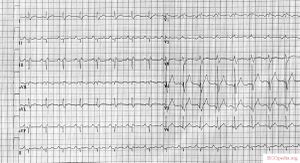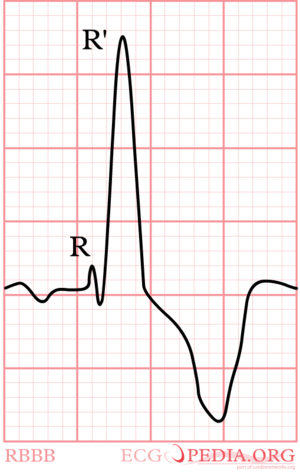RBBB: Difference between revisions
Jump to navigation
Jump to search

m (link to LBBB) |
(made reference visible) |
||
| Line 1: | Line 1: | ||
{{Box| | {{Box| | ||
;Criteria for right bundle branch block (RBBB) < | ;Criteria for right bundle branch block (RBBB) <ref>Garcia</ref> | ||
:QRS >0,12 sec | :QRS >0,12 sec | ||
:Slurred S wave in lead I and V6 | :Slurred S wave in lead I and V6 | ||
| Line 11: | Line 11: | ||
[[MI diagnosis in RBBB|Diagnosing myocardial infarction in RBBB]] is not as difficult as in [[LBBB]]. | [[MI diagnosis in RBBB|Diagnosing myocardial infarction in RBBB]] is not as difficult as in [[LBBB]]. | ||
{{clr}} | {{clr}} | ||
==References== | |||
<references /> | |||
Revision as of 03:29, 13 June 2011
- Criteria for right bundle branch block (RBBB) [1]
- QRS >0,12 sec
- Slurred S wave in lead I and V6
- RSR'-pattern in V1 where R' > R

A 12 lead ECG with right bundle branch block, left axis (LAFB)(and left atrial enlargement)
Again, watch V1. In right bundle branch block (RBBB) the conduction in the bundle to the right ventricle is slow. As the right ventricles depolarizes, the left ventricle is often halfway finished and few counteracting electrical activity is left. The last electrical activity is thus to the right, or towards lead V1. In RBBB the QRS complex in V1 is allways markedly positive.
Diagnosing myocardial infarction in RBBB is not as difficult as in LBBB.
References
- ↑ Garcia
